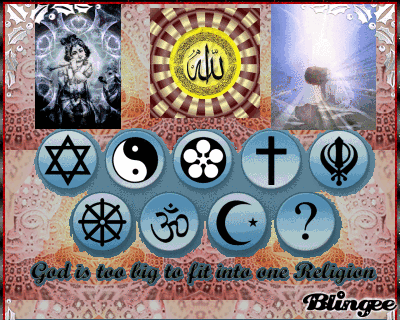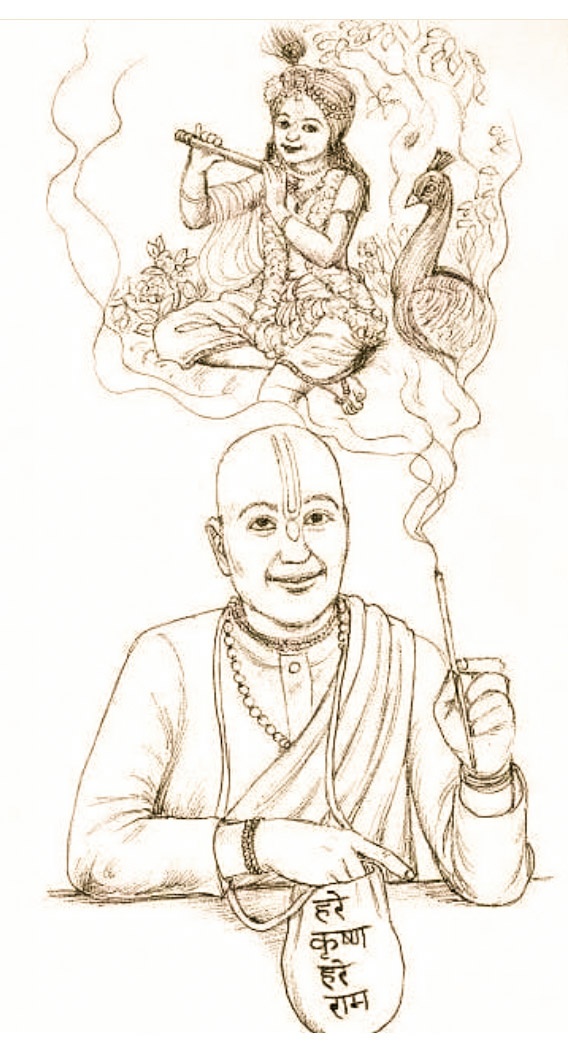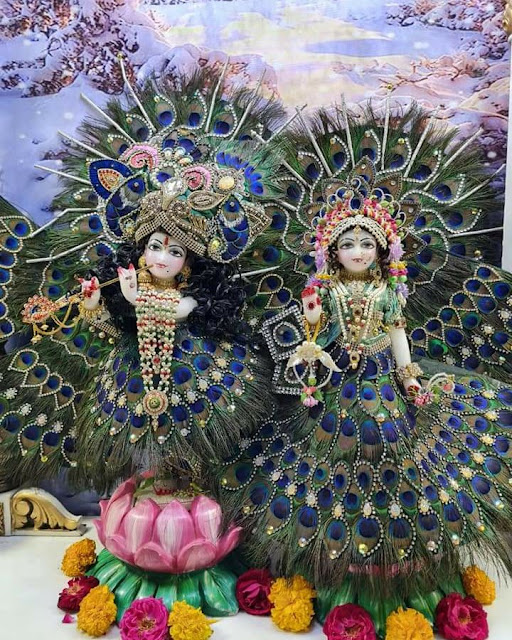Followers
Body - the Temple With Soul as Radhey Krishna
The entrance to the shrine is through steps that represent the six chakras or energy centres. The seventh chakra, sahasrara, is at the centre of the worship hall. Made of translucent onyx marble, it is lit up underneath in the evening to give a beautiful glow.
“A temple represents the visva rupa, the universe, in the form of a man,” says Bhanu Swamigal, citing the Angor Wat temple in Cambodia as an example. “The feet are the main gate and the head is the sanctum sanctorum, housing the deities. Mount Meru, representing the principal deity, is symbolised by the sikharas (peaks) over the deities,” he elaborates. At this temple, the sikharas are in (Odisha style).
The worship hall has huge windows embellished by Vijaya Govinda Dasa's paintings that shimmer in the streaming sunlight. The avatars of Vishnu are depicted, each representing a direction with the corresponding yantra.
The entrance of the temple is marked by the representation of the universe.According to the cosmology of ancient Vedic puranas, the universe is described as series of circular islands surrounding a central pillar called Mount Meru. The design on the floor at the entrance depicts the same universal pattern.
Directions of Avatars
Rama for East (Sun), Nrisimha for South (Mars), Krishna for North-West (Moon) and so on. The cow and the nursing calf at the entrance form a symbol too.It is believed that the eight corners of a temple or any house for that matter are governed by eight avataras of the Lord. These are wonderfully depicted in the large windows of the temple along with a yantra for each. Through the large windows on the Eastern side, the rays of the Sun can be seen reaching upto the deity’s altar revealing His beautiful form. “The cow is a giver; it nurtures life and is a personification of Dharma. Here it stands for the Earth. You take care of it, it gives. You abuse it, it stops producing,” the Swami explains.
Mrityunjaya Yantra
It is modelled on the Mrityunjaya Yantra, ‘the Conquest over Death Yantra’. This is specially represented with the help of onyx marble that is illuminated from underneath. Exactly above is the brahma-sthanam which allows light to stream in through a transparent dome. Here, at this point, light from below and above converge on the observer.
Iskcon Chennai / Article / Videos
http://en.wikipedia.org/wiki/ISKCON_Temple_Chennai
https://www.youtube.com/results?search_query=ISKCON+Chennai
Gopinath
Govinda was so deeply grieved by the loss of his family that he stopped serving Gopinatha. Lord Krishna appeared to Govinda in a dream and asked him, "Govinda! Do you think it is proper that when a person loses one son he should starve his other son to death also?"
To this Govinda replied, "It was my hope that I had my son survived he would have performed the necessary rituals in remembrance of my deceased soul and those of my forefathers. Tell me, what do I gain by serving You?"
Lord Krishna explained, "I hereby promise to celebrate your death anniversary in a fitting manner forever. Now please can I have some food to eat?" Govinda was delighted to hear this and immediately returning to serving Gopinatha.
In course of time, when Govinda breathed his last, Gopinathaji held kusha grass in His fingers to perform the shradha ceremony, a practice continued even today.
Labels
- 10 Types of prayers (1)
- 128 (1)
- 14 Generations (1)
- 15 (1)
- 16 10 5 (1)
- 18 (1)
- 21 (1)
- 27 (1)
- 3 2 1 (1)
- 3 Rathayatras in 3 Days (1)
- 32 (1)
- 36 (1)
- 40 yrs of Janmashtami Celebration (1)
- 44 (1)
- 6 (1)
- 6 Dieties Photos (1)
- 64 (1)
- 72 (1)
- 8 (1)
- A Miracle at ISKCON Temple (1)
- Aarati preparation chart (1)
- Aarti (1)
- Acamana - Sipping Water for Purification (1)
- acolyte (1)
- Agasthiar (1)
- alankaram (1)
- Altar (1)
- ambani (1)
- Andal (1)
- Angaprathatchanam (1)
- Ankurarpana (1)
- Anyone (1)
- Aradhya (1)
- Arch (1)
- archanam (1)
- archavatara (1)
- Archive (1)
- arghya (1)
- Art of Deity Srngara / Ornamentation (1)
- Articles on Deity Worship / Arachana / Blog (1)
- Ashtamangala (1)
- Astham Seva / Aradhana (1)
- balalaya (1)
- Bath (1)
- Bathing - Dressing (1)
- Bhrigu (1)
- BodyTempleWithSoulasRadheyKrishna (1)
- Brahmotsav in Hare Krishna Movement (1)
- BSAMHITA's Channel (1)
- Butter Fly (1)
- Buy to Support Poor People on Street (1)
- Candana (1)
- Carriage (1)
- Carry (1)
- Chaitanya (1)
- Circumambulation (1)
- Clean (1)
- Cleaning (1)
- Clothes (1)
- Cold (1)
- Color (1)
- Companion (1)
- contemporary (1)
- Cow (1)
- Cricket (1)
- Currency (1)
- Dad (1)
- Dance and Repair (1)
- Darshan (1)
- Dasha Avatar Diety / Links (1)
- Dasopachara (Ten fold worship) (1)
- Decorating Radha / Designer Dress Offering (1)
- Deep (1)
- Deepam (1)
- Deities Photos from Different Angles (1)
- Deities World Wide (1)
- Deity Bathing Ceremony (Abhisek) (1)
- deity before deity (1)
- Deity Day Dressing Chart (1)
- Deity Department (1)
- Deity n God (1)
- Deity Pictures Index / Photos (1)
- Deity Worship Seminars (1)
- Demigods (1)
- devaseva (1)
- Dharma (1)
- Dhupa (1)
- Diety / Basic / Search (1)
- Diety of Radha Krishna Description of Hair and Tilak (1)
- Diety Tribe (1)
- Diety Worship - A Muslim Perspective Clarified (1)
- Diety Worship at Home (1)
- Direction of Temple / Benefit of Each / Note (1)
- Door Within Door (1)
- Dry Fruits (1)
- Dwaadasa (1)
- Ego (1)
- Ekalavya - Attained Perfection via Diety (1)
- Endeavour (1)
- Essential Prayers (1)
- Ever (1)
- Fabs (1)
- Faiths (1)
- Family (1)
- Festival of peace (1)
- Flower ornaments of divine couple / Pasttime (1)
- Forms (1)
- Four (1)
- Four Pairs (1)
- Garbhagriha (1)
- Garland (1)
- Gift (1)
- Gita (1)
- God worship days (1)
- Gopinath (1)
- Govindananda (1)
- grapes (1)
- Group (1)
- Hand (1)
- Hare Krishna Program Morning to Evening (1)
- Havan (1)
- Head Gear (1)
- Homa (1)
- House (1)
- How to perform Abhisheka (1)
- How Work Can Be Worship (1)
- idol (1)
- Idol to Diety(Inviting) and Diety to Idol(Sending) (1)
- imagine (1)
- incense (1)
- Indian (1)
- Individual Sevaks or Deities or places / Forum (1)
- Insult (1)
- invocation (1)
- ISKM (1)
- Isvara (1)
- Japa Tapa Dhyana Puja (1)
- Japanese (1)
- Kalasanthi (1)
- Kalpavrisham Vahanam Made Of Pure Gold / Link (1)
- Kanakabishegam (1)
- Kanakadasa (1)
- Key (1)
- Kumbhabhishekham (1)
- Layered Dress (1)
- List of 64 Seva Apradhas - Offences / Solution (1)
- Lord in the Temple (1)
- Lord Kṛṣṇa's Instructions on the Process of Deity Worship (1)
- Lord Rama's worship methods (1)
- LOVE (1)
- Made (1)
- Mandalabhishekam (1)
- Mandir (1)
- Manipuri Dress (1)
- Method of Deity Worship / Detail (1)
- Milk (1)
- Mind Temple (1)
- Minor Vs Major Deity (1)
- model (1)
- Mrit (1)
- Muffler (1)
- Multiple (1)
- MyPersonnelExperiencesWithDeities (1)
- Nama Prathistha of Diety / 108 Significance (1)
- narcissist (1)
- Nikunja (1)
- Nirmalya (1)
- non living places (1)
- Nyasam – Invoking the deity (1)
- Objects (1)
- Offerings By Mind (1)
- Other (1)
- Pañcapātra (1)
- Pancha Suktas (1)
- Panchakala (1)
- Panchapatra (1)
- Pancharatriki (1)
- PanchaSamskarams or Samashrayanam (1)
- Panchopachara Pooja ( Five Fold Worship ) (1)
- Pattabhishekam (1)
- Peacock (1)
- person (1)
- Picture with Deity (1)
- Place (1)
- Plate (1)
- Pooja (1)
- Pradhana (1)
- Prana Pratishta / Videos / Importance (1)
- Pranama (1)
- Puja (1)
- pujan (1)
- Pure (1)
- Purse (1)
- Radha desh (1)
- Radhacharan Dasa: The Deity Designer (1)
- RainBow (1)
- Ramanan50 (1)
- Reform (1)
- Ritual (1)
- room (1)
- Samaradhana (1)
- Sampan (1)
- Samprokshanam (1)
- Sandal (1)
- Sandalwood (1)
- Sandhyavandanam (1)
- sankalpam (1)
- Saree (1)
- Saridhoti (1)
- Seat (1)
- Seattle Thirumanjanam (1)
- sekhar (1)
- self (1)
- Senses (1)
- Serving the Greatest Person (1)
- Set (1)
- Shawl (2)
- Shodashopachara (Sixteen fold worship) (1)
- Shringar (1)
- Shubh (1)
- Six aspects of surrender in the Pāñcharātra (1)
- Sleep (1)
- Smile (1)
- Sri Krsna Pusya Abhiseka / Videos (1)
- Sri Radha Damodara dressed as Laxmi Narasimha deva (1)
- Sri Sri Radha Kalachandji (1)
- Sri Sri Radha Raman's arati (1)
- Srirangam (1)
- Start (1)
- Statue (1)
- Sthothra Rathnam Anubhavam (1)
- Store (1)
- Story Of a Rat (1)
- Stuti (1)
- Suhotra (1)
- Sun and Moon (1)
- Suprabhatam (1)
- Sweater (1)
- synagogue (1)
- Take time to offer a Lamp in Kartik Month (1)
- Taking Steps Toward Krishna (1)
- Temple Architecture (1)
- Then Now (1)
- Thirumanjana (Abhishekams ) Kattiyams (1)
- Three (1)
- Three Stages of Devotional Service and Dieties (1)
- Tilaka (1)
- Together (1)
- Tree (1)
- truth (1)
- Tulsi / Saligrams (1)
- Turn (1)
- Two (1)
- tyagi (1)
- udharini (1)
- Udupi / 14 kinds of pooja daily at UDIPI / Gruel Offer (1)
- Unique Display Of Salagrama Silas (1)
- Upasak (1)
- Upasana (1)
- Upasika (1)
- Upasya (1)
- vadhyar (1)
- Vaishnava Prayers / Hare krishna Songs (1)
- vandana (1)
- Vastu Shastra and Sacred Architecture (1)
- Virtual Temple Tour / Videos (1)
- vithal puja (1)
- Vrindavan (1)
- Want (1)
- Way (1)
- We (1)
- Women (1)
- Worship Method of Three Brothers (1)
- Worship of Feet of Radha Krishna (1)
- Worshiping (1)
- Ya (1)
- Yantra / Vaisnava canon (1)



.jpg)














